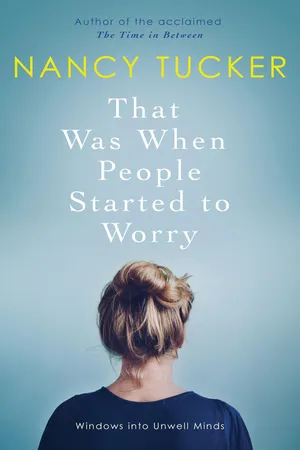
- 256 pages
- English
- ePUB (mobile friendly)
- Available on iOS & Android
About this book
' This is mental illness. It is unexpected strength and unusual luck and an uninterrupted string of steps. Then the next wave comes. And while you wipe grit from your eyes and swipe blood from your knees, the smiling faces in the distance call out: Why do you keep falling over?! Just stand up! 'Conversations about mental health are increasing, but we still seldom hear what it's really like to suffer from mental illness.Enter Nancy Tucker, author of the acclaimed eating disorder memoir, The Time In Between. Based on her interviews with young women aged 16–25, That Was When People Started to Worry weaves together experiences of mental illness into moving narratives, humorous anecdotes, and guidance as to how we can all be more empathetic towards those who suffer. Tucker offers an authentic impression of seven common mental illnesses: depression, anxiety, bipolar disorder, self-harm, disordered eating, PTSD and borderline personality disorder.
Giving a voice to those who often find it hard to speak themselves, Tucker presents a unique window into the day-to-day trials of living with an unwell mind. She pushes readers to reflect on how we think, talk about and treat mental illness in young women.
Frequently asked questions
- Essential is ideal for learners and professionals who enjoy exploring a wide range of subjects. Access the Essential Library with 800,000+ trusted titles and best-sellers across business, personal growth, and the humanities. Includes unlimited reading time and Standard Read Aloud voice.
- Complete: Perfect for advanced learners and researchers needing full, unrestricted access. Unlock 1.4M+ books across hundreds of subjects, including academic and specialized titles. The Complete Plan also includes advanced features like Premium Read Aloud and Research Assistant.
Please note we cannot support devices running on iOS 13 and Android 7 or earlier. Learn more about using the app.
Information
Georgia

| Who’s house are we going to tomorrow?? | |
| Mais xox | |
| Not mine, Alfie has scouts | |
| Charl <3 | |
| Yours G? | |
| Yep sure | |
| Mais xox | |
| Thank yooooooou | |
| Yes haha | |
| Charl <3 | |
| Is your laptop fixed | |
| Charl <3 | |
| Dinner | |
| Mais xox | |
| Same | |
| Charl <3 | |
| Bye | |
| Mais xox | |
| Be good | |
| Don’t die | |


| Charl <3 | |
| Are you coming to mine tomorrow? | |
| Yessssss | |
| Mais xox | |
| My mum says I have to be home by 6 | |
| 6??? | |
| Mais xox | |
| Ikr | |
| Charl <3 | |
| Ffs can’t you stay later? | |
| Mais xox | |
| I can’t my grans coming over | |
| Mais xox | |
| Will you come to mine on Saturday?? | |
| Yes for sure! We’ll have all day then! | |
| Charl <3 | |
| Maybe | |
| Mais xox | |
| Please come Charl … | |
| Charl <3 | |
| Got to go | |
| Mais xox | |
| Ok … | |
| Bye. <3 | |
Table of contents
- Cover
- Title Page
- Contents
- Voice to the Voiceless
- Abby – Depression
- Yasmine – Bipolar Disorder
- Georgia – Self-Harm
- Freya – Anxiety
- Beth – Disordered Eating
- Holly – Post-Traumatic Stress Disorder
- Maya – Borderline Personality Disorder (also known as Emotionally Unstable Personality Disorder)
- Presences and Absences
- References
- Acknowledgements
- Copyright

